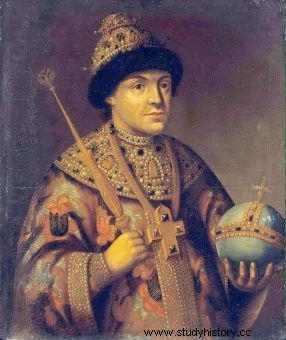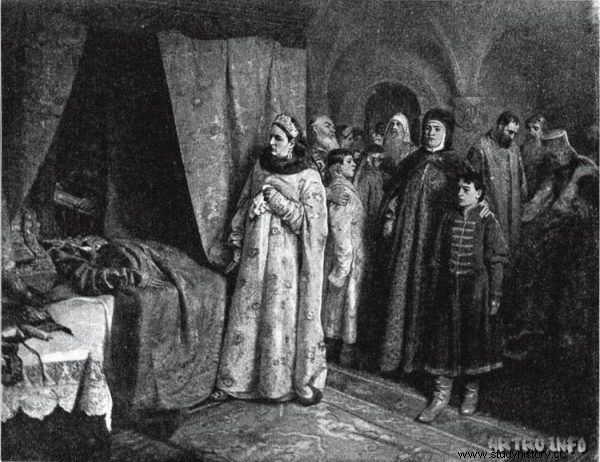The first Russian feminist was Agafia Gruszecka (1663-1681), the Polish wife of Tsar Fyodor (1661-1682). It brought women out of domestic isolation and paved the way for Peter I's reforms.
Nineteen-year-old Fyodor III fell in love with seventeen-year-old Agafia Gruszecka at first sight. He saw her in the Moscow church on April 4, 1680, on Palm Sunday. The monarch's attention was drawn to her bold - for those times - headgear and clothes. The so-called "Polish cap" revealed her hair on the back of her head and on the sides although it was customary to hide them even from members of one's own family. Instead of the traditional button-up dress, this young lady wore an outfit with a small neckline.
It was a serious deviation from the prevailing rules, because in Russia only harlots walked with their necks uncovered . In addition, the stranger was not wearing a ghost-deterrent necklace.
Agafia tsarist fiancée
The intrigued tsar ordered a trusted courtier to gather information about the mysterious young lady. It turned out that the girl's name was Agafia Gruszecka, she was noble, 17 years old and of Polish origin. Her great-grandfather left Poland for Russia at the end of the 16th century.
Agafia's father - Siemion - was, among others a voivode in the town of Chernavsk (now July Oblast in Russia) and the manager of the property of the Lithuanian Hetman Michał Kazimierz Pac. After the death of the head of the family, Agafia and her mother moved to Moscow and lived with the girl's uncle - Andrei Zaborowski, a member of the Boyar Duma.
It was to him, as the guardian of Miss Gruszecka, the in love Tsar Fyodor revealed his marriage plans towards Agafia and ordered "to protect my niece and not to marry her without the permission of [Tsar - V.W.]. The Polish woman turned the young ruler's head so much that the routes of his rides around Moscow ran past the house of the Zaborowski family.

Although among Agafia's rivals there were women from the finest Russian families, Fyodor chose a Polish woman.
Fyodor, despite his absolute power, did not have complete freedom in choosing his spouse. According to Moscow's custom, the ruler had to find a wife during an inspection of hundreds of Russian noblewomen, the greatest beauties of each region, brought to the capital and subjected to strict selection .
Tsar Fyodor organized a traditional inspection, but in his case it was only a formality. Trusted courtiers made sure that Miss Gruszecka was at the last stage of the race. Although among Agafia's rivals there were women from the finest Russian families, Fyodor chose a Polish woman.
… and her own spokeswoman
Fyodor's decision disappointed members of distinguished noble families who counted on increasing influence through the marriage of their daughters. Iwan Miłosławski, the tsar's uncle on the part of his late mother, was particularly appalled. The man dreamed of increasing his role at the tsarist court by offering his nephew his own candidate, but his schemes ended in failure. In order to prevent the marriage with Gruszecka, uncle Iwan informed Fyodor that "she and her mother are known to conduct themselves immoral ", And the tsarist chosen one did not keep her virginity (according to another version, Agafia was born to an unknown mother in a military camp).

The Tsar and his Polish spouse rest in the Kremlin Cathedral of St. Michael the Archangel.
These revelations saddened the monarch so much that he lost his appetite and stopped sleeping at night. Indeed, Fyodor had a hard nut to crack:on the one hand, the tsarina must have had a flawless reputation, but on the other, he himself could not imagine another woman at his side.
The courtiers Iwan Jazykow and Alexei Likhachev came to the aid of the monarch, who went to Andrzej Zaborowski as Agafia's guardian and began to confer on how to verify the revelations about the Polish woman without hurting her feelings - after all, the young lady was a tsarist fiancée ! Unexpectedly, the problem was solved by Agafia herself, who overheard the conversation and entered the meeting room.
Her appearance itself was a sensation, as young, unmarried women were forbidden to see male guests, let alone talk to them ("From childhood until marriage, the virgins live in their father's house in the farthest rooms and can see only family members" - wrote the chronicler Grigory Kotoszychin).
Only married women, ladies of the house, could greet particularly important guests, but only when the husband wanted to honor those visiting his house.
Agafia not only appeared in front of unknown men, but also spoke on her own behalf:
Let the Tsar have no doubts about my purity, I will guarantee the truthfulness of these words with my life.
It was a violation of another principle of family life, according to which the man was the spokesman and representative of his family.
Upon being informed of the results of the investigation, Fyodor did not hide his joy and immediately ordered preparations for the wedding, which took place in July of that year.
Reformer
Agafia went to live in the Kremlin. She was expected to lead a secluded life in the so-called The "female part" of the palace, as her predecessors did. Moscow Tsarits were not allowed to attend court parties, which they could only watch from hiding. Once upon a time, envoys of Jan III Sobieski they were to present gifts to the father of Tsar Fyodor III and his wife, which was to be a return for the generous gifts from the Moscow ruler. In the Western custom, the emissaries were expected to receive the honor of two separate audiences, to the ruler and the ruler - but Alexius received the guests without a wife, explaining to them that she was ill, although in fact she was in good health at the time. English diplomats also encountered a similar situation.
Agafia was an educated woman ( knew Latin, understood French, although she could not speak it; in addition, she played the harpsichord ) and - for those times - emancipated. An isolated life behind the thick walls of the Kremlin was the last thing she dreamed about. Immediately after the wedding, the Polish woman and her husband began to attend services in city churches. The spouses entered the temple together, not hiding from the prying eyes of Muscovites.

Fyodor III died shortly after his beloved wife
Agafia threw the first ever name-day party and invited all the boyars. When foreign envoys appeared in the Kremlin, Fyodor received them together with his wife, who sat next to him on his own throne.
The courtiers were shocked that the young tsarina interfered with state affairs. When in 1680 a certain official in the court of Tsar Fedor was to be punished for allegedly stealing 300 rubles, the 17-year-old Tsarina Agafia demanded that the case be investigated.
However, the reign of the progressive tsarina lasted just over a year. Agafia, 18, died on July 14, 1681, just 3 days after the birth of her son Ilya. Fyodor, devastated by his wife's death, was unable to accompany her on the last journey. The monarch's pain was aggravated by the imminent death of the newborn child. Six months after the departure of his wife, the tsar, urged by the courtiers who awaited the birth of the heir to the throne, married a second time.
Bad health (including scurvy) made it impossible for him to consummate this marriage. Fyodor III died a year after the death of his Polish wife. Tsar and Agafia rest in the Kremlin Cathedral of St. Michael the Archangel.
Bibliographer:
- V. Wiernicka, Polish women who ruled the Kremlin. Warsaw, 2018
